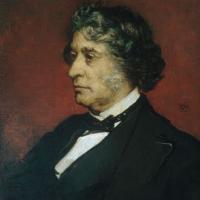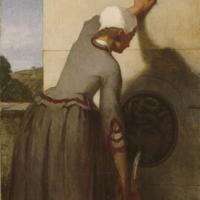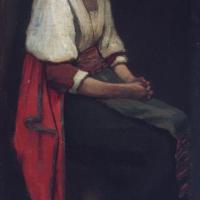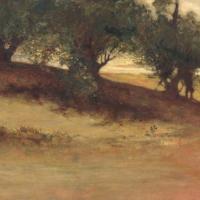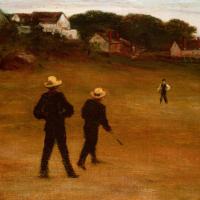William Morris Hunt
William Morris Hunt
William Morris Hunt (March 31, 1824 – September 8, 1879), American painter, was born at Brattleboro, Vermont, to Jane Maria (Leavitt) Hunt and Hon. Jonathan Hunt, who raised one of the preeminent families in American art. William Morris Hunt was the leading painter of mid-19th-century Boston, Massachusetts.
William Morris Hunt was born into prominence: Hunt's father's family, the Hunt family of Vermont, were among Vermont's founders and largest landowners; his mother's a family of wealth and prominence in Connecticut. Hunt attended Harvard College but withdrew in his junior year. Having been denied the opportunity to paint and draw by an overbearing father, Jane Leavitt Hunt resolved that her children would be given the chance to study the arts in the best academies—even if it meant moving to Europe to attend them.
Following the death of his Congressman father from cholera in 1832 at the age of 44, Hunt's mother Jane took him and his brothers to Switzerland, the South of France and to Rome, where Hunt studied with Couture in Paris, coming under the influence of Jean-François Milletafter being greatly inspired by Millet's The Sower at the 1851 Paris Salon. The Hunt family remained in Europe for a dozen years. During part of that time, William Morris Hunt and his brother Richard Morris Hunt shared an apartment at 1 rue Jacob, close by the École des Beaux-Arts, where William studied painting under Thomas Couture. "From the training and inspiration each of the brothers was to experience in the next several years in France would come great strides for each in his work," writes historian David McCullough. "'Mr. William Hunt is our most promising artist here,' reported Thomas Appleton to his father." Hunt then spent the next two years under the tutelage of Millet in Barbizon before his return to the states.
The companionship of Millet had a lasting influence on Hunt's character and style, and his work grew in strength, in beauty and in seriousness. He was among the biggest proponents of the Barbizon school in America, and he more than any other turned the rising generation of American painters towards Paris.
After leaving Paris, Hunt painted and used his family connections to establish art schools in Newport, Rhode Island, Brattleboro, Vermont, the Faial Island in the Azores, and finally in Boston, where he became popular portrait painter.
Before his lauded return to America in 1855, Hunt was married in Paris to Louise Dumaresq Perkins, daughter of Thomas Handasyd Perkins, Jr., a Boston merchant, philanthropist and patron of the arts. Hunt was married to Ms. Perkins again upon his return to Boston in 1855, perhaps for legal reasons. Hunt was married for the second time in the influential King's Chapel in Boston by academic and clergyman Ephraim Peabody, shortly before Peabody's death in 1856.
William Morris Hunt died at the Isles of Shoals, New Hampshire, in 1879, apparently a suicide. Hunt had gone to the New Hampshire shore to recover from a crippling depression. But he continued to work, executing his last sketch three days before his death. His body was discovered by his friend, New Hampshire poet Celia Thaxter.
The William Morris Hunt Library of the Boston Museum of Fine Arts is named in honor of this painter. (Hunt was a founding member of the Museum of Fine Arts' museum school). Following Hunt's death, his Harvard classmates and other Bostonians contributed to a fund to purchase many of his paintings and donate them to the Museum of Fine Arts.
Aside from the Museum of Fine Arts, the Boston Athenaeum has a number of the artist's works in its collection, a gift of William Morris Hunt II. Also owning works by Hunt are New York City's Metropolitan Museum of Art, the Louvre Museum in Paris, the Musée d'Orsay in Paris, the Fine Arts Museums of San Francisco, the National Gallery of Art in Washington, D.C., the Addison Gallery of American Art at Hunt's alma mater Phillips Academy in Andover, Mass., the Bennington Museum, Vermont, the Bowdoin College Museum of Art, the Brooklyn Museum of Art, the Carnegie Museum of Art in Pittsburgh, the Currier Museum of Art in New Hampshire, the Harvard University Art Museums, Salem's Peabody Essex Museum, the Pennsylvania Academy of the Fine Arts and many others.
In accordance with a long expressed desire, William Morris Hunt was buried at Prospect Hill cemetery in Brattleboro, Vermont, beside other family members. Two decades after Hunt's death, his former pupil Helen Mary Knowlton published her biography of the Boston painter entitled The Art-Life of William Morris Hunt.
William Morris Hunt and his wife, the former Louisa Dumaresq Perkins, had five children. Morris sat for a full-length portrait by the artist Emanuel Leutze in Düsseldorf in 1864. Formerly part of the collection of Col. Leavitt Hunt at Elmshome in Vermont, the location of that portrait is now unknown.


